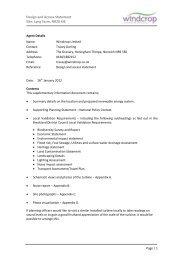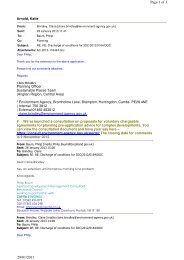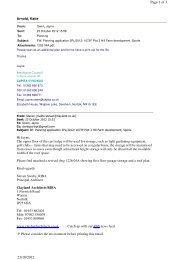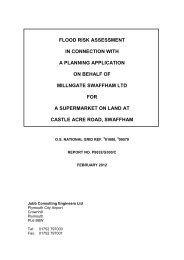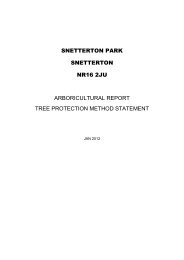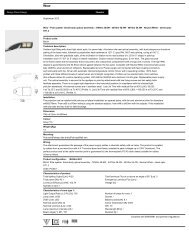view - Breckland Council
view - Breckland Council
view - Breckland Council
You also want an ePaper? Increase the reach of your titles
YUMPU automatically turns print PDFs into web optimized ePapers that Google loves.
5.14 All of the above are, as we say, a cause for concern in land use planning terms and warrant action;<br />
namely improved and increase food shopping choice in Thetford with the aim of improving retention<br />
rates.<br />
5.15 From NLP’s 2010 work the TAAP makes comment on the need for additional food floorspace provision<br />
in Thetford over the plan period. In particular:-<br />
That the 2010 Study suggested less capacity than the earlier 2007 Study.<br />
What capacity there is should be directed to the new urban extension in the form of a small local<br />
supermarket.<br />
Any residual capacity (estimated at 330m² (net) convenience floorspace should be directed to the<br />
town centre.<br />
5.16 Against this emerging policy background it is worth noting that:-<br />
Retail capacity or ‘need’ no longer forms part of the policy test for retail proposals at national level.<br />
The capacity estimates are based on maintaining/not increasing market share. In short, the<br />
capacity estimate presumes Thetford will continue to retain just 65% of the available spend from<br />
Zone 1.<br />
5.17 In respect of the second point above, it is highly significant that Thetford and Zone 1 achieves a very low<br />
overall retention rate when compared against other zones and centres. So:-<br />
Within Zone 2 (Dereham) - 78% of residents do their convenience shopping in Dereham.<br />
In Zone 3 - 79% of residents do their food shopping in either Swaffham or Dereham.<br />
In Zone 4 - 88% of residents do their food shopping in Dereham, Swaffham or Watton.<br />
5.18 In our opinion Thetford should positively plan to increase its market share. By doing so it will retain<br />
shoppers in the town, which can only be to the benefit of other retailers in the town. Secondly, it will<br />
help to reduce unsustainable shopping trips to more distant towns (e.g. Diss).<br />
5.19 We consider Thetford should strive to achieve food shopping retention rates closer to those achieved<br />
across the other zones (i.e. 75% to 85%). Doing so would increase retail capacity. For example, if<br />
Thetford were to achieve the lowest of the above retention rates (78%) it would suggest a further<br />
£13.30M (2008 prices) of capacity at 2016.<br />
Former Tulip Factory Site, London Road/Caxton Way, Thetford Page 24<br />
Retail & Planning Statement, February 2012





